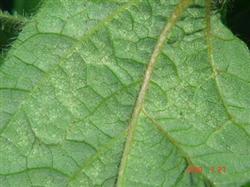The cause of empty chaff of soybean

1. The difference of breed. The occurrence of middle and late maturity varieties was more serious, while that of early and middle maturity varieties was lighter. two。 Drought and waterlogging during childbearing period are the key factors leading to high grain rate. The best rainfall at the flowering and pod stage of soybean is 180 mm. In the flowering and pod stage of soybean, the harm of waterlogging is more serious than that of drought, especially in the disaster of waterlogging, the rate of empty grain and lodging are high. In addition, if the sowing time is dry, it will postpone sowing, delay the emergence of seedlings, reduce the accumulation of energy during soybean growth, and also cause empty chaff grains of soybean. In the later stage, if the low temperature affects the filling speed of soybean, it will also result in a higher rate of empty grain. 3. The lack of boron and molybdenum in soil is another main reason for the formation of high empty grain rate. Boron and molybdenum are essential trace elements for soybean development and are closely related to pod formation. If the content of boron and molybdenum in the tillage layer of the soil is low and there is no topdressing when planting soybean, it is bound to increase the empty grain rate of soybean. Especially for continuous cropping soybean, the rate of empty grain per plant increased year by year. At present, there are still some phenomena, such as shallow fertilization depth, planting fertilizer in the same bed, in the same position, and low fertilizer utilization efficiency, which affect the improvement of soybean yield.
- Prev

The main reason of soybean flower and pod dropping
Soybean seedling blight is commonly known as "dead tree","damping-off" and "black root disease". In serious disease years, the death rate of plants in light disease fields is 5%~10%, and the death rate of plants in serious disease fields is more than 30%. Some fields even die completely, resulting in no yield. Field symptoms: soybean blight occurs only at seedling stage, seedling and young plant taproots and...
- Next

Occurrence and Control of Soybean Red Spider
Red spider is a general term for red spider mites, which is a composite population of several species of spider mites and belongs to the spider mite family. In Huachuan County, it occurs in different degrees every year, but it belongs to light occurrence year. However, according to this year's survey, due to the recent high temperature and drought, the damage of red spiders to soybeans in Huachuan County has risen from a secondary position to a major one.
Related
- The first cup of black tea in spring, the flavor and history of tea gardens in Kenya, Africa
- The computer can not only choose potatoes, but also grow tea rice. AI will grow winter oolong tea champion.
- It is not only the inflated tea bitten by insects, but also engraved with the four seasons tea in Beipu.
- The Oriental Beauty Tea Festival in Zhuxian County takes the stage at the weekend to experience the plus-size feast of oil tea.
- & quot; Oriental Beauty Tea & Exploration of Emei in Hsinchu, the hometown of quot;
- The new variety of strawberry "Tainong 1" dessert is the first choice with mellow aroma. Crimson gorgeous
- History of Tea in Taiwan: from Wild Inner Mountain to Export Tea Garden
- Two types of Taiwan Oriental Beauty Black Tea won the British three-Star Award for Childhood Tea Xiang Zhang Jiaqi changed from pilot to champion tea maker.
- Banana species and varieties: the planting history of Taiwan Xianren banana and dwarf banana is long, is banana disease resistant?
- Coffee planting Technology: Qianjie Coffee from Seedling to harvesting

